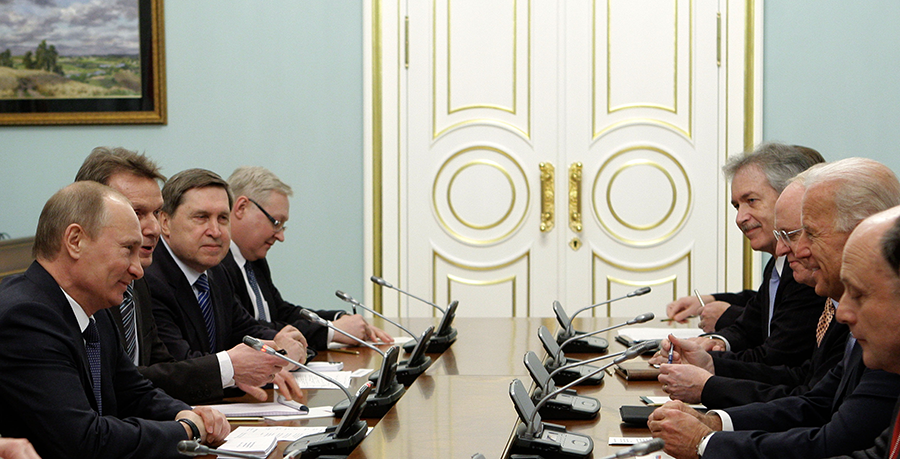"Though we have acheived progress, our work is not over. That is why I support the mission of the Arms Control Association. It is, quite simply, the most effective and important organization working in the field today."
Biden’s First Challenge: Extend New START
January/February 2021
By Daryl G. Kimball
Until the Trump era, every U.S. president since John Kennedy has successfully concluded at least one agreement with the Soviet Union, or later Russia, to reduce the dangers posed by nuclear weapons to the United States and the world.
 President Donald Trump did not. He and his team failed to resolve a dispute over Russian noncompliance with the 1987 Intermediate-Range Nuclear Forces (INF) Treaty and bungled talks to extend the last remaining U.S.-Russian nuclear arms control agreement, the 2010 New Strategic Arms Reduction Treaty (New START), which is due to expire Feb. 5.
President Donald Trump did not. He and his team failed to resolve a dispute over Russian noncompliance with the 1987 Intermediate-Range Nuclear Forces (INF) Treaty and bungled talks to extend the last remaining U.S.-Russian nuclear arms control agreement, the 2010 New Strategic Arms Reduction Treaty (New START), which is due to expire Feb. 5.
As a result, the top foreign policy priority of President Joe Biden, once he is sworn in, must be to dispatch a senior representative to reach agreement with Russia on a clean, five-year extension of the treaty (the maximum allowed under the agreement) and begin follow-on nuclear disarmament talks on the backlog of issues the two sides have failed to resolve since New START was concluded.
The loss of New START would deprive the United States of an irreplaceable source of information about Russian strategic forces, create the potential for unconstrained nuclear competition, and further complicate the already fraught U.S.-Russian relationship. For the first time since 1972, there would be no agreed limits on the world’s two largest nuclear arsenals.
During the campaign, Biden said he would pursue an extension of New START, “an anchor of strategic stability between the United States and Russia and use that as a foundation for new arms control arrangements.”
Russia has recently reiterated it “supports extending the treaty for five years without additional conditions.” To date, however, Biden’s team has not signaled whether he will seek a longer- or shorter-term extension or what type of follow-on agreements he will pursue.
Extending the treaty by five years would enhance U.S. and Russian security by maintaining the treaty limits of 1,550 deployed strategic warheads and 700 deployed strategic delivery systems, ensure newer Russian strategic weapons are covered by the treaty’s limits, and provide the most time for the complex negotiations that will be necessary for any follow-on agreement or agreements to supersede New START.
There is no evidence that a shorter-term extension of New START would make Russia more likely to negotiate a follow-on agreement. Nor would a one-year or two-year extension provide enough time to negotiate a meaningful, durable replacement agreement.
With mere days to effect an extension of New START, the Biden administration should not try to hold an extension hostage to the Trump administration’s ambitious, 11th-hour proposal to impose a one-year cap on all types of U.S. and Russian warheads—a proposal that Moscow is not close to accepting.
A temporary freeze on the number of all types of U.S. and Russian warheads would be a useful confidence-building measure, but a one-year freeze on warhead totals would be of limited value given that neither side could significantly increase the size of its arsenal in such a short time.
Upon announcing an agreement to extend New START, Biden and Russian President Vladimir Putin should issue a joint communique expressing their commitment to quickly resume strategic stability talks, begin negotiations on a follow-on agreement to achieve deeper mutual reductions in their stockpiles, and seek to engage other nuclear-armed states, which possess far smaller but still deadly arsenals, in the nuclear disarmament enterprise.
A key objective of the next round of bilateral talks should be, in part, deeper verifiable cuts in deployed strategic nuclear weapons. In 2013 the Obama administration determined that the United States could reduce its nuclear force by one-third below New START levels and still meet deterrence requirements. Follow-on negotiations should also address nonstrategic nuclear weapons; the interrelationship between offensive nuclear weapons and strategic missile defenses; long-range, dual-capable conventional missiles, including those formerly banned by the INF Treaty; and hypersonic glide vehicles.
Trump officials argue that the next arms control treaty must include China without explaining how this might be accomplished. Extending New START and pursuing serious follow-on talks designed to limit all types of Russian and U.S. nuclear weapons would certainly enhance U.S. leverage to bring China and the other nuclear-armed states further into the nuclear risk reduction process. But rather than repeat Trump’s failed scheme to shame Beijing into joining complex trilateral talks, Biden should propose a regular, bilateral strategic security dialogue with China and an expansion of the existing P5 dialogue on nuclear matters, which China already supports.
The P5 process could be reconfigured to become a genuine negotiating forum where the Biden administration could propose regular reporting by all states on total nuclear weapons holdings and a freeze on the size of Chinese, French, and UK nuclear forces so long as the United States and Russia pursue deeper nuclear cuts.
A straightforward, no-nonsense five-year extension of New START would provide the new president with an early win and positive momentum, help restore U.S. credibility on arms control issues, and create the potential for more ambitious steps to reduce the nuclear danger and move us closer to a world without nuclear weapons.
